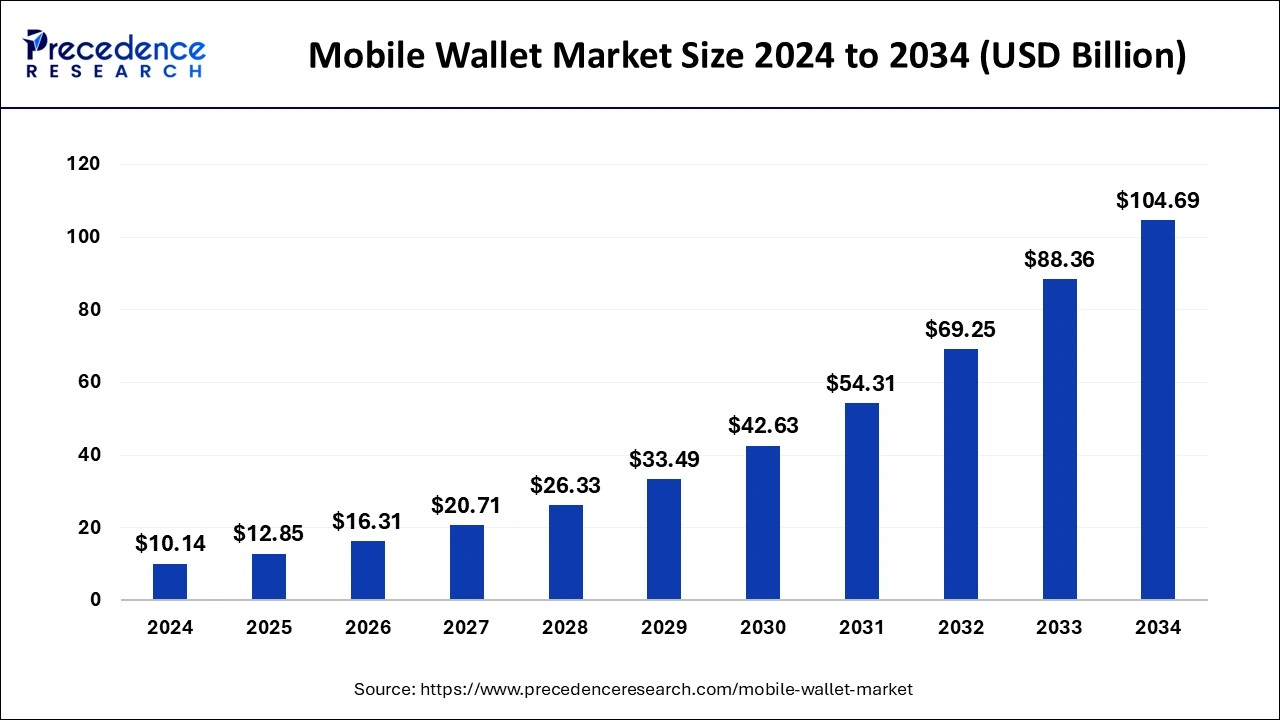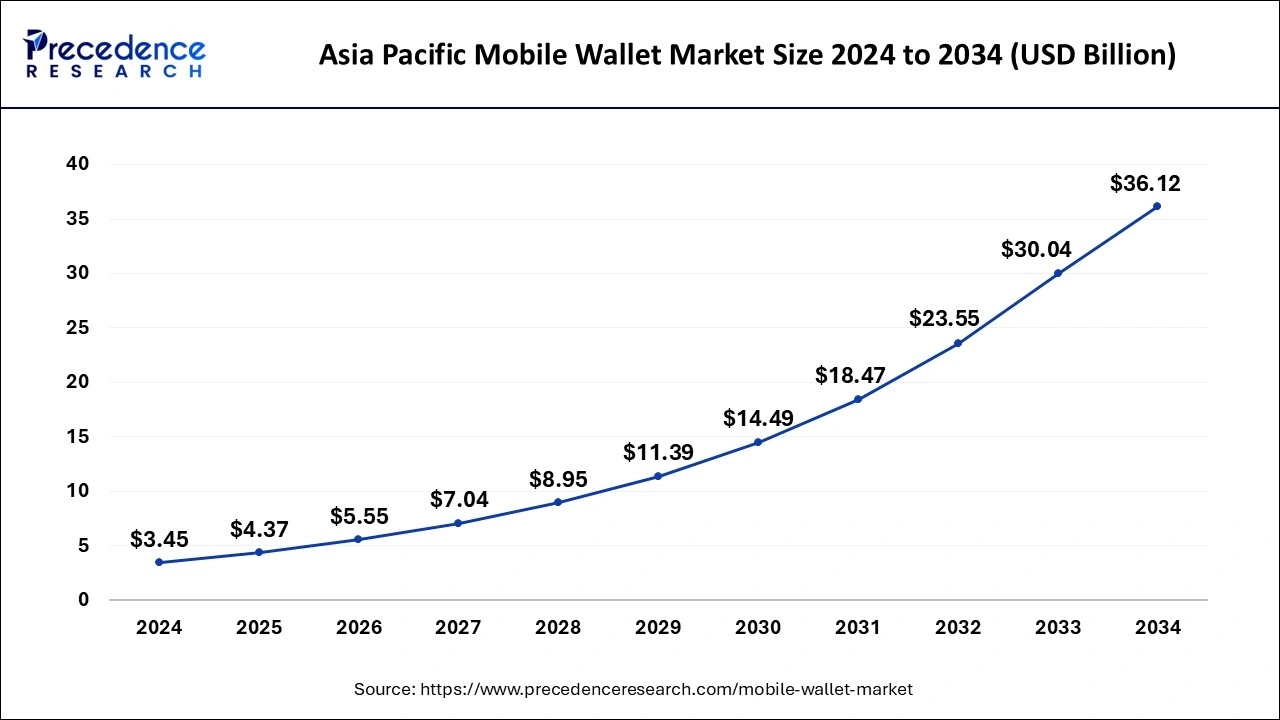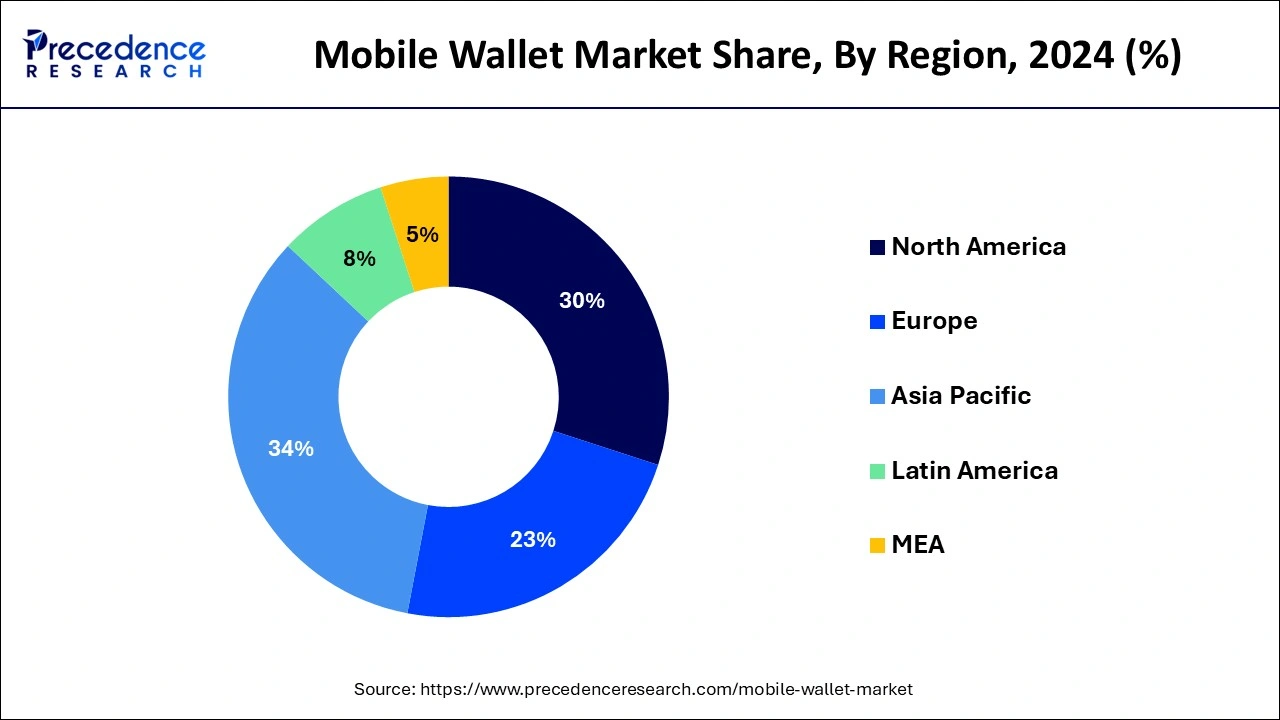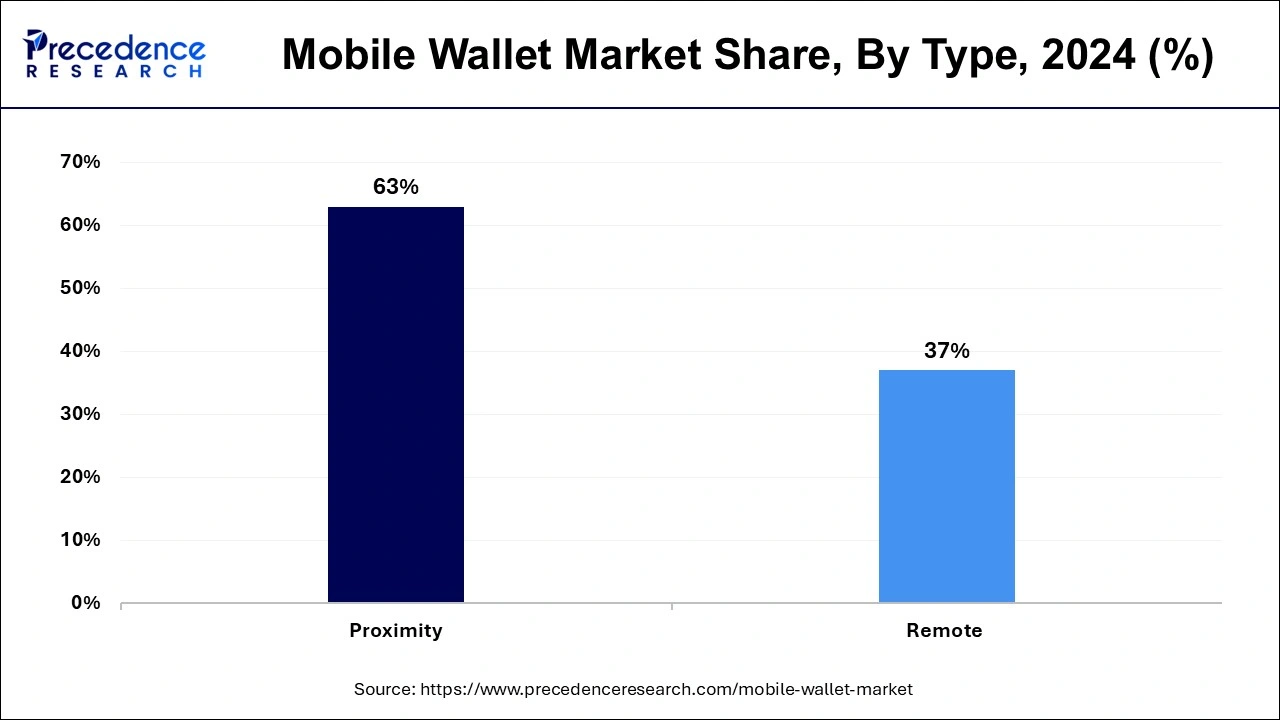January 2025
The global mobile wallet market size is calculated at USD 12.85 billion in 2025 and is forecasted to reach around USD 104.69 billion by 2034, accelerating at a CAGR of 26.30% from 2025 to 2034. The Asia Pacific mobile wallet market size surpassed USD 4.37 billion in 2025 and is expanding at a CAGR of 26.47% during the forecast period. The market sizing and forecasts are revenue-based (USD Million/Billion), with 2024 as the base year.
The global mobile wallet market size was estimated at USD 10.14 billion in 2024 and is predicted to increase from USD 12.85 billion in 2025 to approximately USD 104.69 billion by 2034, expanding at a CAGR of 26.30% from 2025 to 2034.

The Asia Pacific mobile wallet market size was valued at USD 3.45 billion in 2024 and is anticipated to reach around USD 36.12 billion by 2034, poised to grow at a CAGR of 26.47% from 2025 to 2034.

Asia Pacific dominated the mobile wallet market in 2024 while contributing 34% of the market share. The dominance of the region is attributed to the rapid pace of urbanization, advancement in technology, well-established financial infrastructure, a supportive regulatory framework of the government, the emerging trend of digitalization, and the rising use of contactless payment solutions which facilitates the high adoption of mobile wallet services in the region. In recent years, the mode of payment has shifted from cash to debit cards to online transactions, and this transition has led to the advent of contactless payment options, including mobile wallets.
The robust growth of the retail and e-commerce sector across developing countries such as India, Japan, and China is boosting the market's revenue. Consumers in the region are adopting mobile payments increasingly rapidly due to the increasing number of smartphone and internet users. The supportive government initiatives have boosted the digital payments industry to promote a cashless economy and introduced several policies and regulations, such as Digital India and Make in India, resulting in the rising acceptance of mobile wallets.

Prominent companies in the region are aggressively working to increase user engagement and retention by offering loyalty programs, discounts, and exclusive offers within their mobile wallet platform. Companies are also embracing IoT while leveraging the potential of advanced technologies such as blockchain and AI to ensure the security of transactions. Thus, such factors are expected to propel the mobile wallet market’s growth in the region during the forecast period.
The mobile wallet market refers to the ecosystem of digital platforms and applications that enable users to store, manage, and transact money electronically using their smartphones or other mobile devices. Mobile wallets offer a convenient and secure alternative to traditional payment methods such as cash, checks, or physical credit/debit cards.
Anyone can use them at any merchant where digital payment is widely accepted. The need for a faster and more convenient way of money transfers is compelling people to use mobile wallets, which are gradually becoming more common and preferred by customers. Mobile wallets often integrate with other apps, including ride-sharing, online shopping, and food delivery services, enabling users to make payments conveniently within those apps.
Mobile wallets enable users to make in-store payments quickly and easily. They facilitate convenience and security to the users as well as offer rewards. Digital wallets such as Apple Wallet, Google Wallet, and Samsung also allow users to store and use loyalty cards, membership cards, coupons, boarding passes, event tickets, and other items on their smartphones.
| Report Coverage | Details |
| Growth Rate from 2025 to 2034 | CAGR of 26.30% |
| Market Size in 2025 | USD 12.85 Billion |
| Market Size by 2034 | USD 104.69 Billion |
| Largest Market | Asia Pacific |
| Base Year | 2024 |
| Forecast Period | 2025 to 2034 |
| Segments Covered | By Type, By Application, and By Technology |
| Regions Covered | North America, Europe, Asia-Pacific, Latin America, and Middle East & Africa |
Increasing adoption of contactless payments
The rapidly rising adoption of contactless payments across the globe is expected to boost the market's revenue during the forecast period. In recent years, mobile wallets have grown rapidly due to customers' preference for quick, safe, and touchless transactions in physical and virtual establishments. The robust growth of the mobile wallet market is encouraged and promoted by the tech-savvy society, where consumers inclination to integrate digital payment methods into their daily lives. Therefore, the increasing usage of contactless payment is anticipated to fuel the market expansion in the coming years.
Lack of awareness
The lack of awareness is anticipated to hamper the market's growth. The need for more understanding of mobile wallets in middle and lower-income countries prevents users from adopting mobile wallets. The low trust in mobile wallets is also a major factor. Several consumers are reluctant to adopt mobile wallets in their daily lives as contactless payment due to the fear of fraud, such as leaked data, hacking, and other security issues, which is likely to limit the expansion of the global mobile wallet market.
Increasing use of smartphones and rising internet penetration
The rising use of smartphones, coupled with growing internet penetration across the globe, is projected to offer immense growth opportunities to the market during the forecast period. The use of mobile wallets increased as the market witnessed the rising use of smartphones, resulting in the rapid adoption of digital payments. The increasing use of smartphones indicates the growing acceptance of mobile wallets. Smartphone and internet users can make the most use of the mobile wallet functionalities. Moreover, mobile payment systems are expanding beyond the usage of smartphones and tablets with the various uses of wearable technology, including smartwatches.
The proximity segment held the largest share of 63% in the mobile wallet market in 2024, and it is expected to sustain its position throughout the forecast period. A proximity wallet is used for authorization and transactions involving entities that are generally physically close to each other. The proximity interaction is between the mobile wallet and the control or acceptance entity. In today's market, there are various proximity-based payments available, including NFC, MST, UHF, and others. These are the leading technologies boosting the segment's growth. With the use of proximity technology, a user can easily pay for goods and services with their smartphones or any smart device at a physical point-of-sale terminal.

The remote segment is expected to grow significantly at a CAGR of 28.7% during the forecast period. Remote wallets are also known as digital wallets, cloud wallets, or e-wallets. The entities involved in the authorization and transaction process are not physically close to each other. Remote wallets are usually connected with loyalty programs or value-added services.
The retail and e-commerce segment held the largest share of 34% in the mobile wallet market in 2024. Mobile wallets are designed to simplify the process of purchase for customers; It saves time at checkout in retail shops, eliminates the hassle of carrying cash, and helps shoppers plan their expenses accurately. In addition, it encourages purchasing through using a loyalty program. The benefits of accepting mobile wallet payments are becoming popular in retail and e-commerce. Retailers integrating cashless or contactless payment technology are intended to gain consumer data opportunities and loyalty.
The banking segment is observed to grow at a CAGR of 29.8% during the forecast period. Banks are established financial institutions with a long history of trust and reliability. Consumers are more inclined to use mobile wallets provided by banks because they perceive them as secure and trustworthy. Banks already have a large customer base, providing them with a significant advantage in promoting and distributing mobile wallet services. They can leverage their existing relationships with customers to encourage adoption of mobile wallet solutions.
The QR Code segment dominated the mobile wallet market in 2024; the segment is observed to grow in the coming years. QR codes are one of the most popular contactless payment methods in which a mobile app scans a specific image. QR codes are encrypted, which ensures that the transaction is safe and facilitates a faster and more reliable method of payment. Customers generally use their device's camera and the wallet's scanning function to make purchases for in-store payments. This technology uses the merchant and payment processor information included in the bar-coded image.
The NFC segment is expected to grow at a rapid CAGR rate during the forecast period. NFC is the technology that enables contactless payment. NFC solutions allow users to integrate existing payment cards through mobile phones, and the activation of payment services ensures convenience and security. This technology permits two devices, such as your phone and a payment terminal, to communicate with each other while nearby (about an inch and a half, or 4 centimeters). This technology is considered more secure than a physical credit card.
By Type
By Application
By Technology
By Geography
For inquiries regarding discounts, bulk purchases, or customization requests, please contact us at sales@precedenceresearch.com
No cookie-cutter, only authentic analysis – take the 1st step to become a Precedence Research client
January 2025
August 2024
December 2024
November 2024